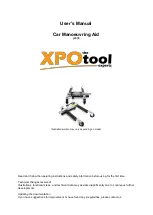
3: C
on
so
le O
pe
ra
tio
n
•
2
1
©2012 Axia Audio
playout system, telephone hybrids, etc.
“Channel” would normally be used when referring to
DESQ’s linear faders or RAQ’s rotary faders and associ-
ated controls, OLED displays, bus assignment keys, etc.
Sources are assigned to faders for use on-air or in
production. During initial configuration, the Source
Profiles are programmed by the engineer for appropri-
ate logic and options (as outlined in previous chapters);
afterwards, whenever that source is assigned to a fader,
source logic follows.
Fader settings are instantly reconfigured whenever a
source is selected, to accommodate the unique require-
ments of the source. For example, a fader controlling a mi-
crophone source also controls appropriate monitor mutes.
A fader controlling a line source may send “start” and
“stop” commands when the channel is turned on and off.
Sources such as an off-air feed can also be assigned
directly to the monitors for auditioning without being as-
signed to a fader.
Mix-Minus
Mix-minus setup, especially for live broadcasts, has
always been one of the most confusing aspects of run-
ning a radio console. RAQ/DESQ makes mix-minus
easy by automating it. The operator never has to worry
about sending a source back to itself and getting feed-
back — it just can’t happen!
Several fixed and auto-switching mix-minus choices
are possible, and are configured for each source when
Source Profiles are defined by the engineer (see
Chap-
ter 2
for details). Once this setup is done, no further
tweaking is needed; the operator simply uses the source.
A fader’s status display tells operators when a particu-
lar source has a mix minus output, and even tells them
which audio mix is being backfed.
RAQ/DESQ will generate as many mix-minus out-
puts as there are faders, each with its own automated
mix minus feed. Each of your six faders can produce a
mix-minus!
Chapter Three:
Console Operation
Overview
RAQ and DESQ are designed to perform well in
small studios. The clean interface enhances speed and
accuracy without clutter or confusing controls.
In this chapter we’ll first give you a high-level over-
view of the capabilities of the surfaces. Then, we’ll give
you detailed explanations of the various controls and
functions.
Displays
RAQ and DESQ have an OLED display for metering.
The meters can be configured to VU or PPM metering
standards.
RAQ/DESQ have a dedicated meter displaying Pro-
gram 1 and the second meter postion can display other
buses by pressing the meter button.
In addition to the meter displays, the DESQ has a
time of day clock and a count-up timer. RAQ does not
have this additional display.
Show Profiles
The RAQ or DESQ can be completely re-configured,
instantly, to suit different types of needs. By recalling
any of four previously stored Show Profiles, talent can
change board settings to suit different needs at the touch
of a button.
Show Profiles are easily toggled by pressing the
Pro-
file
key located at the top of Monitor section. Construc-
tion and administration of Show Profiles is covered in
Chapter 4: Show Profiles.
Sources, channels and Faders
During the course of this chapter, we’ll refer of-
ten to
sources
and
channels.
These are not the same!
“Sources” are microphones, CD players, outputs from the
Содержание DESQ
Страница 1: ...RAQ DESQ Installation User s Guide Manual Rev 1 January 2012 p n 1490 00086 001...
Страница 8: ...Introduction viii 2012 Axia Audio...
Страница 10: ...Introduction x 2012 Axia Audio Crimping the spade lugs the smell of soldering flux they ll be missed Not much...
Страница 12: ...Getting Started 2 2012 Axia Audio Open box connect Seven pounds of pure power Who needs big consoles...
Страница 30: ...2 Inputs and Outputs 20 2012 Axia Audio CAT 6 small and light yet sound and data pour forth What magic is this...
Страница 61: ...6 Advanced Controls 51 2012 Axia Audio Mimicking nature streams combine to form anew many become one...
Страница 80: ...Axia Audio a Telos Alliance Company 1241 Superior Ave Cleveland Ohio 44114 USA 1 216 241 7225 www AxiaAudio com...
















































